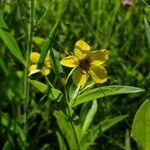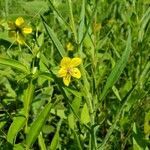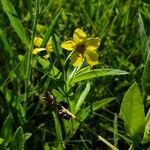Stems erect, simple or sometimes branched distally, 1-10 dm, glabrous (rarely sparsely stipitate-glandular or pubescent near nodes); rhizomes slender; bulblets absent. Leaves opposite or whorled near stem apex, dimorphic; distal petioles absent or 0.1-0.7 cm, proximal 0.3-2(-3.5) cm, ciliate proximally, cilia 0.3-1.2(-2) mm; distal blades narrowly elliptic to elliptic-lanceolate or linear-lanceolate, proximal blades broadly elliptic or lanceolate, distal 3-18 × 0.2-1.6 cm, proximal 2-5 × 0.6-1.8 cm, bases of distal leaves cuneate, decurrent, bases of proximal leaves rounded to obtuse or cuneate, decurrent, margins entire (rarely serrulate), plane, ciliolate proximally, apex rounded to acute or acuminate, surfaces not punctate, glabrous; venation pinnate-arcuate. Inflorescences axillary, solitary flowers. Pedicels 1-5 cm, glabrous to sparsely stipitate-glandular (rarely pubescent). Flowers: sepals 5, calyx not streaked, 3.5-8(-10) mm, glabrous or stipitate-glandular, lobes narrowly lanceolate to ovate, margins thin; petals 5, corolla yellow, sometimes with slightly reddish base, not streaked, rotate, 4-10 mm, lobes with margins slightly erose apically, apex apiculate or mucronate, sparsely stipitate-glandular adaxially; filaments distinct or nearly so, shorter than corolla; staminodes 0.7-1 mm. Capsules 2-5 mm, usually not punctate, glabrous or slightly stipitate-glandular distally. 2n = 34.
More
Erect from long, slender, stoloniform, superficial rhizomes, 2–9 dm, the lateral branches scarcely exceeding the subtending lvs; lower cauline lvs ovate to obovate, petioled; principal lvs linear to lanceolate or narrowly oblong, to 15 × 1.5 cm, often folded along the midrib, paler beneath, scabrellous on the margin or ciliate near the base, gradually tapering below, often with little or no distinction of petiole and blade; cal-lobes firm, 4–7 mm, the nerves, especially the lateral ones, obscure or hidden; cor-lobes 5–10 × 4–6 mm; fr 2–4.5 mm thick; 2n=34. Moist or wet woods and prairies; N.J. and Pa. to n. Fla., w. to Wis., Io., Mo., and e. Tex. June–Aug. (Steironema l.; S. heterophyllum)



